... earthquake 13 June 2011 ...
sponsored by:
Sponsor Logo
space for lease

|
... earthquake 13 June 2011 ... |
sponsored by: |
Sponsor Logo |

|
|
Christchurch [Page under edit.. N.B. review of this eastbound fault-extension EVENT THESIS]: [Back to] 4 September 2010 or 22 February 2011 or 23 December 2011 InfoHelp earthquake page Much editing to follow.. DRAFT: With a third major 6.3-magnitude or greater local earthquake to report and comment on, we therefore have this new page. It is important because, having with a measure of accuracy predicted the event sequence, fair laying out of the means for prediction is required - it will help others, at the least to understand (much). What causes earthquakes? - Why, earthquakes do of course. I am not being trite. If tectonic geological forces are the main shapers of our physical world, it pays us to learn their language - earthquakes: a never-ending trigger sequence of underground motion and stress-pressure release, that constantly displaces stress energy for other earthquakes to release - sooner or later but inevitably. It has been going on forever, and humanity has enjoyed a short, 10-20,000 year window of relative tectonic calm in which we have prospered as a type of dominant species on Earth. But all that can so easily change. Arguably, it already has. 16 June retweet: "Wake up New Zealand: Earth's youngest land & latest settled, the 1st being broken up by faster global #warming & #climate change #eqNZ #ChCh". That is what we must know. Our society has to adapt quickly, for a much greater level of resilience from a smallish resource base, with economic adaptability. "The shakey isles" have deterred migrants in the past, are doing so now, and could really be getting much worse as an investment prospect: a reality check for all Kiwis. Some earthquake prediction method is now outlined here: 5.7 south-west Tonga Trench ridge quake shakes NZ Recap Christchurch earthquake indexing: #1. 04 September 2010 - magnitude 7.1 #2. 22 February 2011 - magnitude 6.3 #3. 13 June 2011 - magnitude 6.3 - this page #4. 13 August? (saw a small aftershock swarm), 22nd (a bigger swarm) or 31st (a still bigger swarm, mag 4.8) - 4th (mag 4.4), Sept? 2011 - (19th 4.3) some say 28th ... 23 December 2011 - magnitude 6.0 #5. During next ~100,000 years - magnitude 6+ on Kaiapoi fault - Fault off Kaiapoi may spark marine quake (15Nov12)? #1. A large part of the prediction has been intuitive - a gut feeling - which proportion is being balanced over time as a wider and wider range of data signal is now being read. So for earthquake #1 my prediction was all intuition - a feeling of imminent likelihood, that I posted publicly in the form of emergency preparedness alerts a year early, mid-August 2009: "The Alps are tensioned like a rubber band, science says, with a 250-300 year 'snapping' overdue. Before the worst case scenario so described, any number of smaller scale fault slips could occur, and are now occurring in Fiordland. A 7.8 shake anywhere along the Alps could impact tragically upon nearby buildings and lives, and in scale. Are we prepared?" R U Ready 4 The Big One?. It was my job to represent the Canterbury public interest in disaster response, as Civil Defence and Emergency Management portfolio chair at Environment Canterbury from November 2007. As a councillor for Christchurch East I was actively promoting preparedness plans with local resident groups, of Sumner, Redcliffs, Southshore and New Brighton initially. e.g. Exercise Pandora 2009 Sadly this work - so important in light of what happened since - was stopped by the National Government's scrapping of elected representation at ECan, in favour of their farmer/investor constituents' dairying prodfits, in April 2010. As with the lives lost carelessly at Pike River, the corporate bosses have a lot to answer for. #2. I asked the question "What's going on below?" about obvious large 'drag' movements on the GeoNet Banks Peninsula seismometer, on Facebook on 5 February 2011 - adding the striking graph for people to see. This was prescient for the disaster soon to unfold on 22 February, and the only early warning - apart from Ken Ring's - that I am aware of. 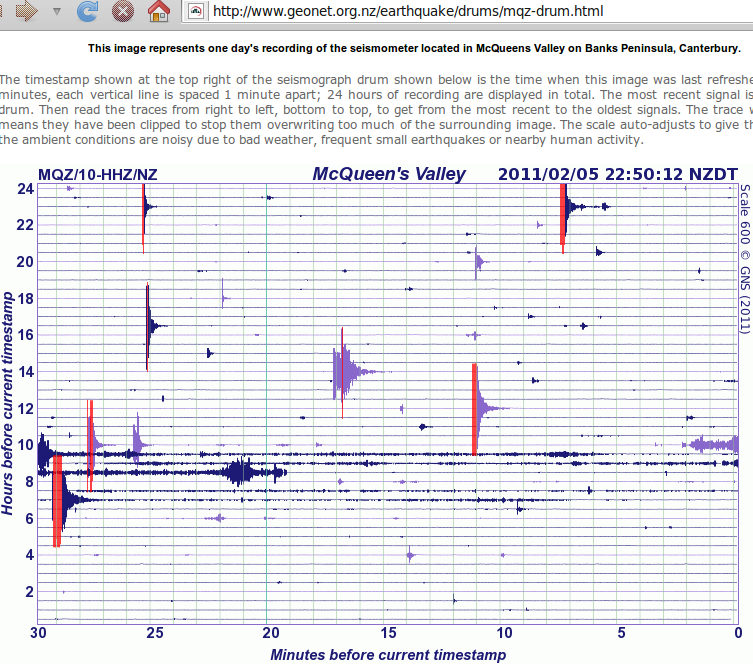 #3. prediction was the most specific and correct. Again on Facebook, I had a warning out the night before the 'surprise' Rolleston 5.5 aftershock - correctly picking the following morning but expecting a greater magnitude. Then I gave warning that Lyttelton would be next, and soon. The correct timing and equivalent size was deduced from the following interpretation of Chris Crowe's graph: 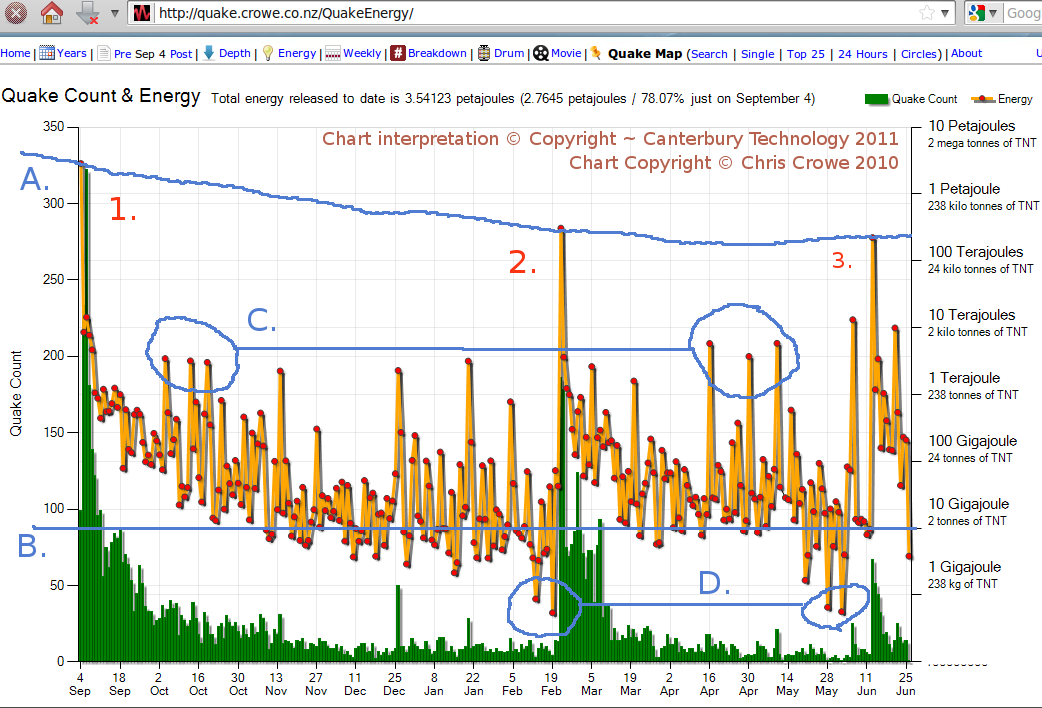 A. curve shows a rate of decline that is completed by a third (fourth, fifth..?) earthquake, that then arrived on 13 June. B. line is 10-Gigajoule average daily energy release, that 4 September's quake had slowly dropped to before 22 February unleashed more; 22 February daily energy release had dropped to this same level just before 13 June, allowing correct new quake prediction based on that [Quake #4 is most likely to repeat this pattern [1], and: C. and D. daily energy release peak and trough patterns - as these triples and pairs matched up with similarity, my feeling was that another repeat in the cycle had threfore now become imminent. Proven correct. Review of eastbound fault-extension EVENT THESIS: 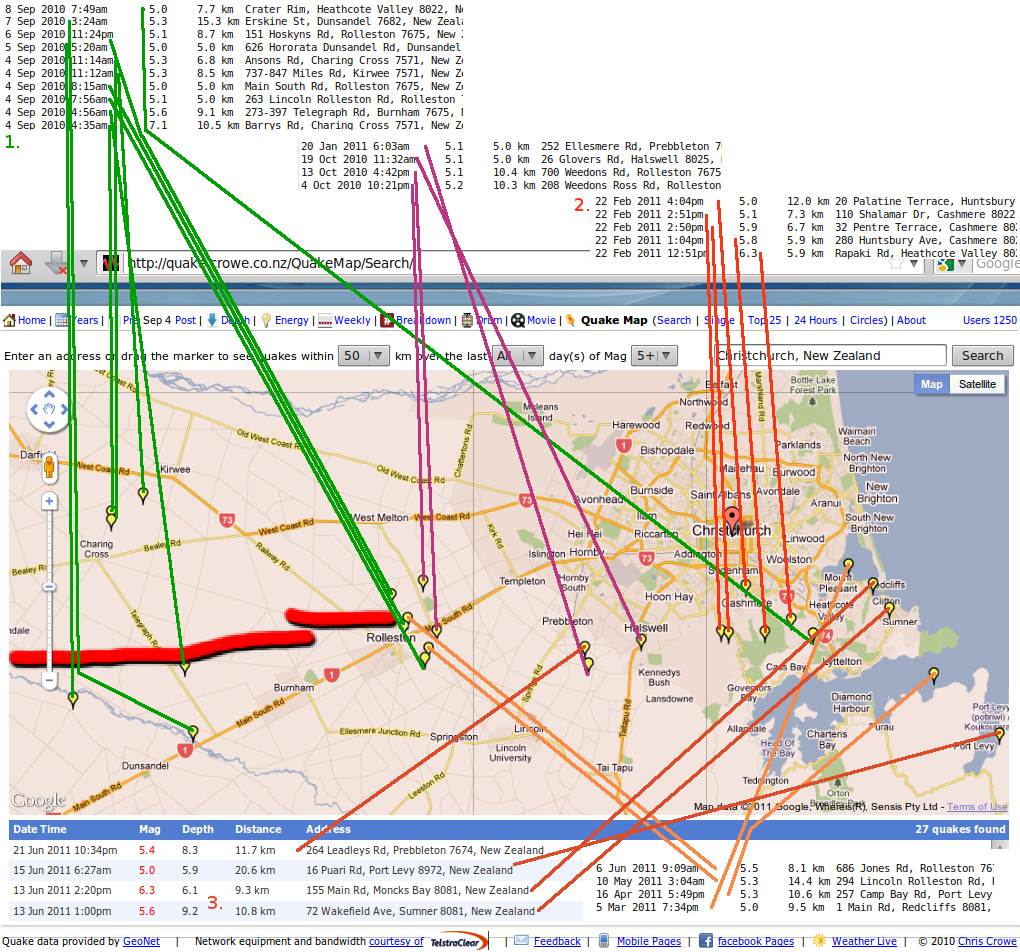 West to east migration of main shocks - 1, 2, 3, - is very clearly confirmed through date and location mapping. But has that quake migration now been thwarted and absorbed, by the ancient circular faults of Lyttelton crater, as the science so describes?: ... 5.5 aftershock "third worst day since September 4th" reports TV3 News re total energy released by A trio of tremors "GNS Science duty seismologist Brian Ferris said the magnitude-5.5 aftershock was 'within the forecast we expected'. It was not a sign of "anything big" to come, but it was likely that small aftershocks would follow today's quake. 'It's possible there'll be an increase in activity in the area, but it's unlikely anything as big will occur,' he said." Press 6Jun11 & Quake just 'a classic aftershock' "not ominous. The 5.5 magnitude quake at 9.09am - centred near Rolleston and 15 kilometres deep - was felt as far away as Westport and Dunedin.. within expected forecasts and not a sign of anything big to come" 7Jun11 & 'It's not our fault' - scientists Press 8Jun11 - message suddenly changed to: 13Jun11 Powerful earthquakes rock Christchurch Press & Higher risk of even more shocks "important to realise the risk estimates, and any other aftershock forecasts, were only computer models based on average quake sequences and not derived from any physical evidence.. Given their similar positions, scientists say the 1pm earthquake is believed to be a foreshock of the second quake" & Depth of 5.5 tremor revised to 8km & GNS upgrades earthquake strengths "largest earthquake has been upgraded to magnitude 6.3, with a shallower depth of 6km.. The 1.01pm tremor has also been upgraded to 5.7, and was at a depth of 10km" 14Jun11 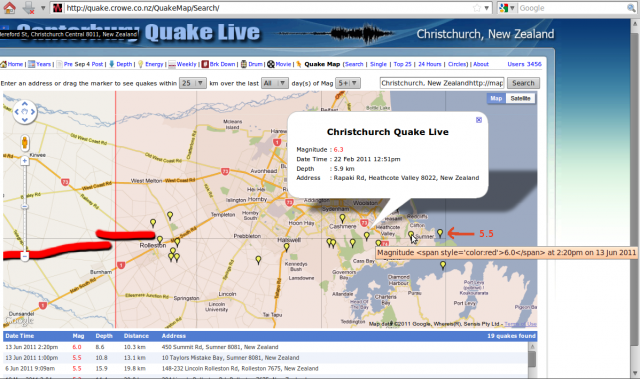 Three main/large shocks line up; initial locations, 22Feb11 x1 + 13Jun11 x2: Crowe.co.nz Lyttelton area magnitude 5 and larger earthquakes 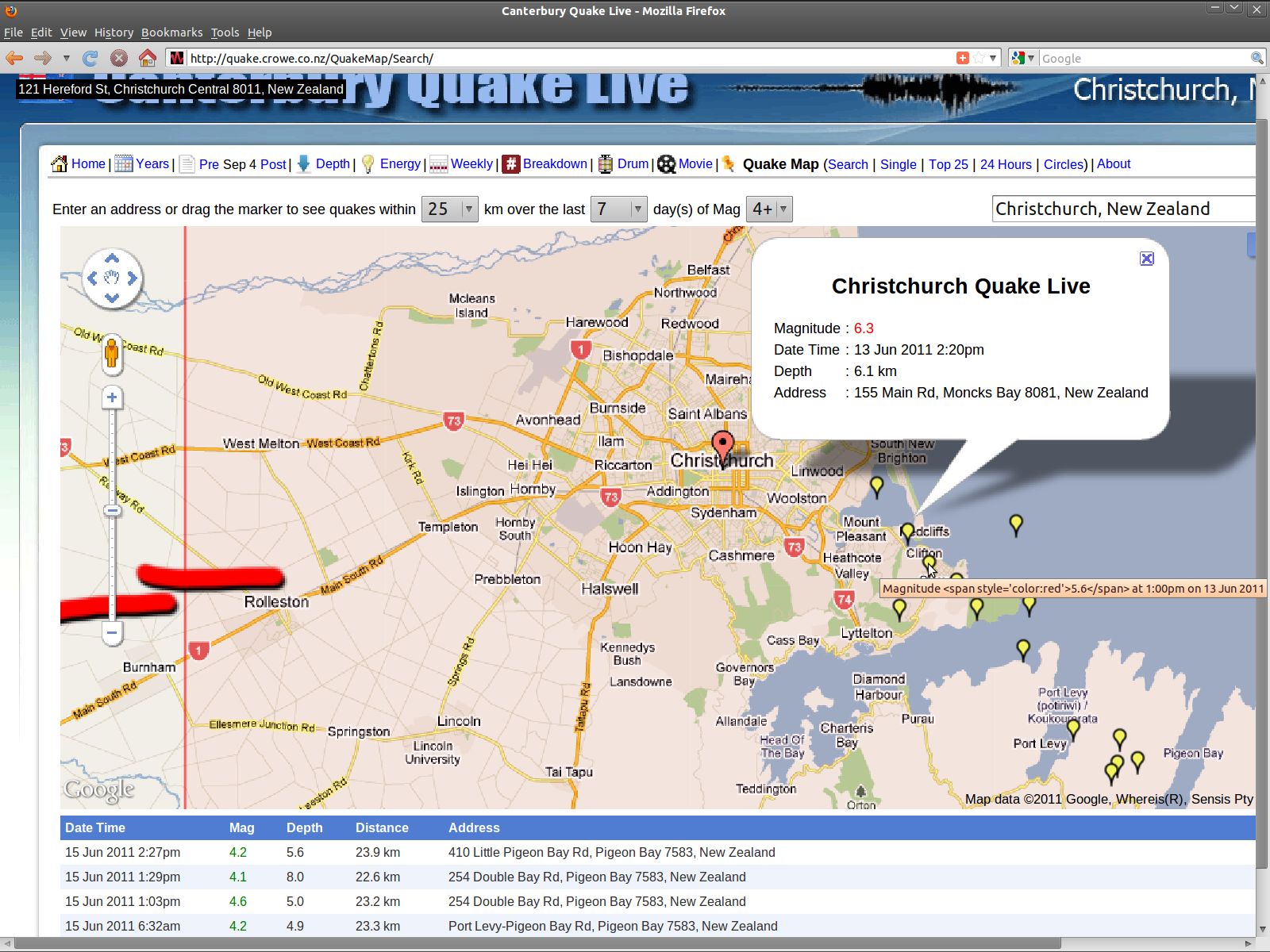 Revised locations 3 days later and more 4+ aftershocks clearly show transmission of rift energy onto Port Levy-Pigeon Bay fault: Be Prepared ~ Monday's earthquakes 'lift risk to 30pc' Press 15Jun11 Visions for Christchurch Kennedy Graham 16Jun11 vs? Trends in natural disasters 1900-2000 graph UN & TheWatchers.adorraeli.com blog * * * * * Are Progressives in Denial About Climate Change? Labor Network For Sustainability Compost Toilets for Christchurch New Brighton workshop & blog + The Shock Doctrine and The EQ Response in Christchurch Action for Christchurch East blogspot 15Jun11 EQC chief defends quake response "'unprecedented' nature of the events.. Ian Simpson admitted about 2000 tradespeople in Christchurch were owed overdue payments by the EQC.." Press 17Jun11 + A rubbish week "..a fair chance that Monday's quakes were instead simply further ruptures on the original Port Hill's fault - ones on a "splay" that forked off at a different angle towards the surface above. 'So they could be linked at depth in the subsurface,' [University of Canterbury Prof Jarg] Pettinga explains. The different angles would explain why February 22 was felt as a fast up-and-down motion while Monday's was more a bucking side-to-side. Pettinga says the reason why there was no warning of the fault's existence is that ground imaging equipment can only probe for faults buried under sediment layers and the Port Hills fault is part of the hard rock making up the old Lyttelton volcanic cone. Since Monday, what scientists have been noticing is that the aftershocks have been radiating steadily around the sides of the cone, heading eastwards towards Port Levy and that side of the Banks Peninsula. GNS Science researcher Martin Reyners, who has been tracking the progress, says even this is good news probably. Reyners says when the volcano was forming in a series of eruptions millions of years ago, it would have created a ring of small fractures around it. It now looks like these are mopping up most of the energy released by the Port Hills fault. Certainly the activity is spreading away from Christchurch and is scattered enough not to appear to be focused on any further large faults. Reyners adds the public should also know that scientists hold no fears for the volcano itself. 'There've been a lot of calls about new hot springs appearing in the Port Hills and the water of Lyttelton harbour getting warmer.' But Reyners says all the instruments show the volcano is inactive. 'There's no magma bubbling up underneath because of all this.' So the evidence is that we are still in a seismically active period. Monday confirmed that. And because so much more energy was dumped into the landscape by the latest events, GNS Science has had to raise the odds to a 30 per cent chance of seeing another earthquake of between 6 and 7 in the current aftershock zone over the next year. But on the other hand, says Pettinga, the total activity is in fact slowly subsiding as the landscape rebalances. And the patterns of activity are moving away from the city as far as we can tell." 18Jun11 + Call for quake-resistant rebuild 20Jun11 & Structural Timber Innovation Company STIC.co.nz "Sustainable Buildings of the Future ..research aims to develop different timber engineering solutions involving innovative large-span timber building technologies primarily for use in non-residential buildings ..collective of major participants in the Australian and New Zealand timber industries and leading research organisations with the joint goal of a step-change increase in the number of timber buildings constructed" PO Box 8211 Riccarton Christchurch 8440 17 more Canterbury sites eyed for temporary housing "The Department of Building and Housing says it is considering another 17 sites in Canterbury to be used as temporary accommodation villages. Housing Minister Phil Heatley visited the nearly complete Kaiapoi village on Wednesday morning, saying it is likely to be the first of many because demand is outstripping supply. In six weeks, part of the Kaiapoi domain has become a full functioning temporary community with 22 houses ready for tenants within two weeks. During the tour, department staff told the minister that about 200 people had said they are in desperate need of temporary accommodation. Mr Heatley says it is likely the initial three sites in Linwood, Kaiapoi and New Brighton will quickly fill to capacity. Seventeen other sites which the minister will not name are being assessed for suitability. Mr Heatley says feedback from displaced residents shows they want plenty of smaller villages so that they can remain near local facilities such as schools. Rental agencies have questioned the need for temporary homes, saying there is many empty private rentals available." RadioNZ 29Jun2011 ChristchurchQuake.co.nz Blair K IT support Total Business Technology 744 Gloucester St Avonside & QuakeHelp.co.nz "non-profit, web-based entity aimed solely at helping the people of Christchurch city" & My Christchurch Business is Open .co.nz Auckland etc links Humanity Road, Inc. "nonprofit organization dedicated to educating the public with critical recovery information before, during and after a catastrophic disaster" humanityroad.org US Gondwana Wikipedia geological processes etc & Evolution of Whales Gondwana graphic South Australia + Incorporated Research Institutions for Seismology IRIS Global Seismographic Network GSN + Earthquakes 5 times more energetic than 20 years ago "research proves that destructive ability of earthquakes on Earth increases alarmingly fast and that this trend is set to continue, unless the problem of 'global warming' is comprehensively and urgently addressed" + Fire and Ice: Melting Glaciers Trigger Earthquakes, Tsunamis and Volcanos "Geologists Say Global Warming Expected to Cause Many New Seismic Events" environment.about.com NB "In the south-west, the Pacific Plate has a complex but generally convergent boundary with the Indo-Australian Plate, subducting under it north of New Zealand forming the Tonga Trench and the Kermadec Trench. The Alpine Fault marks a transform boundary between the two plates, and further south the Indo-Australian Plate subducts under the Pacific Plate forming the Puysegur Trench. The southern part of Zealandia, which is to the east of this boundary, is the plate's largest block of continental crust." Pacific Plate Wikipedia - Therefore the eastern South Island, with the extensive bulk of Zealandia continent submerged before it out to sea, has massive weight-inertia too. In effect, Zealandia's barely-movable mass is what obstructed the Indo-Australian Plate to a local halt, and forced the Southern Alps up in the process, around six million years ago. From that view, we can deduce that when Pacific Plate movement energy is sufficient, Zealandia will be the last thing to move - and with terrible force. This is how we must begin to understand, with preparedness, the vagaries of Mainland life. ~ Kia ora Ref. see Pushing New Zealand's Boundaries GNS Science animated land-formation simulation on youtube Lack of aftershocks a good sign - expert "Cantabrians can be cautiously optimistic they may be through the worst of the earthquakes, a visiting United States seismologist says. Professor Kevin Furlong, of Pennsylvania State University, said quake activity and energy release from the three biggest shakes were decaying steadily. But that did not mean there would not be any more large quakes. He said the lack of big aftershocks for more than a fortnight reflected a general decay in activity. "It's a nice decay. We had the first one in September, and that activity has decayed, and then the February quake, which decayed off but seems to have decayed faster," he said. "Then with the June event, that has decayed faster than the February one. "So the overall decay is there and each of the big aftershocks decayed faster than the one before. That is all very encouraging." There was nothing in the data to suggest there could be another "spike" in activity.." Press 8Jul11 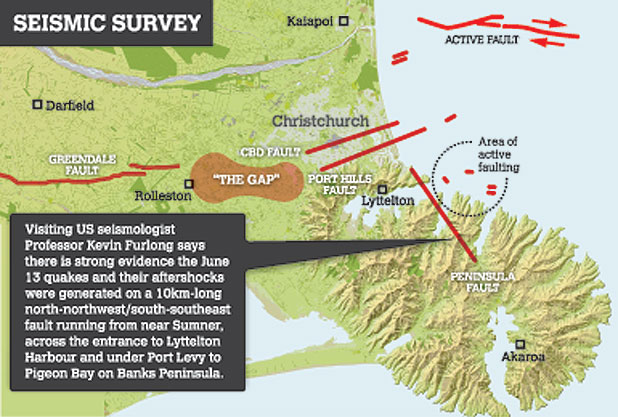 Lidar filters bush to reveal Alpine Fault The Press 21/11/2011 |
Your best chances of spotting a killer quake ahead of time? ~ Discussing the state of integration of the earthquake sensing system, that could one day save lives in "shakey isles" New Zealand 1. Palmer Station, Antarctica seismic heliplot, here recording a Tonga magnitude 5.0 - ahead of Argentina's 4.9 and 22.5 hours ahead of Alaska's 7.2, 24Jun11 (second view six hours later): 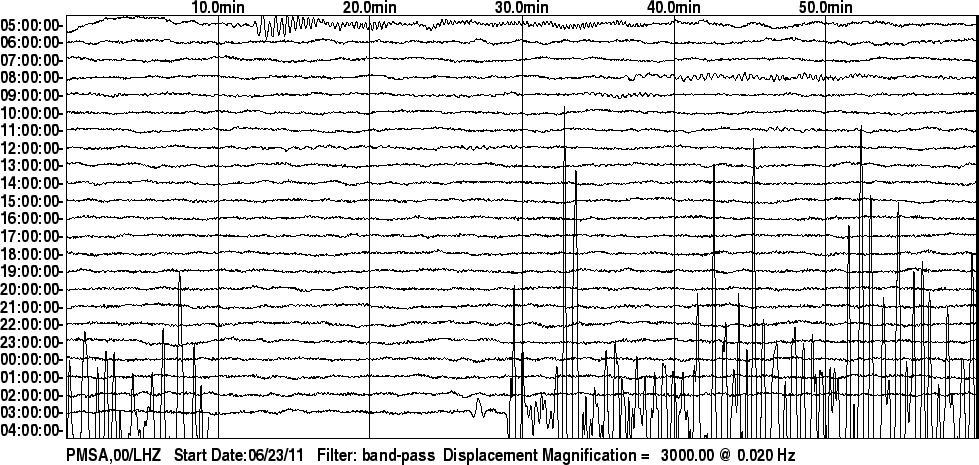 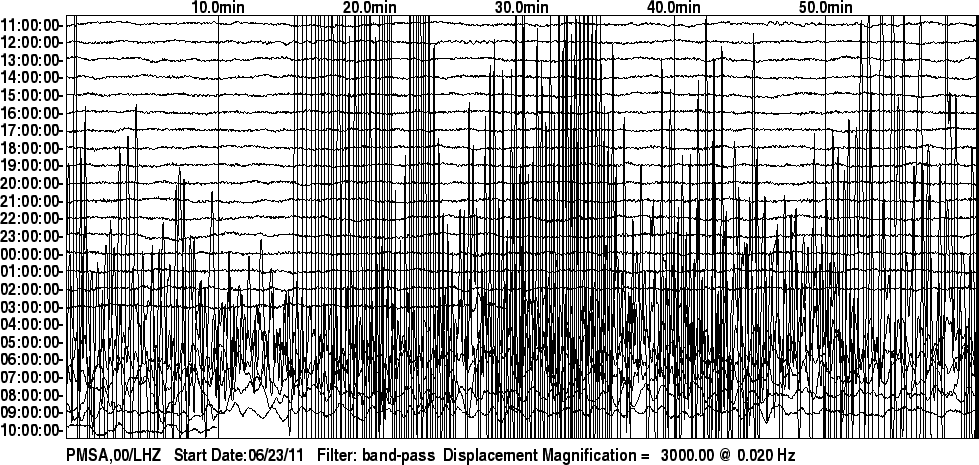 2. Mount Erebus Volcano Observatory, Antarctica Seismic Activity erebus.nmt.edu esp same 24Jun11 event: 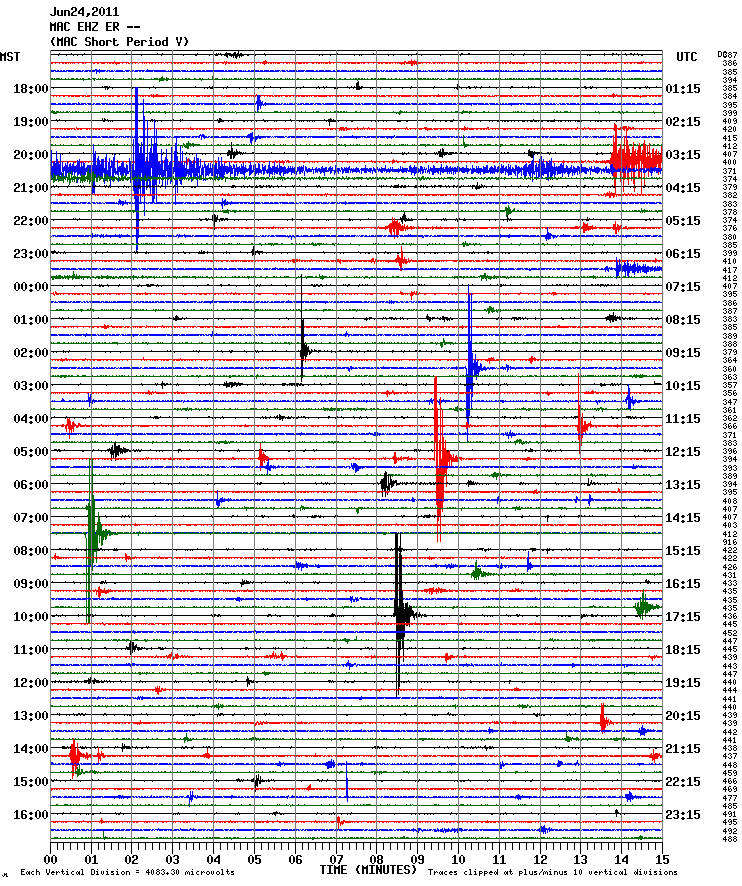 3. Raoul Island Volcano in the Kermadecs seismic activity chart geonet.org.nz here showing period after Santa Cruz / Solomon Islands 6.1 quake then Halswell mid-Canterbury 5.4 21Jun11: 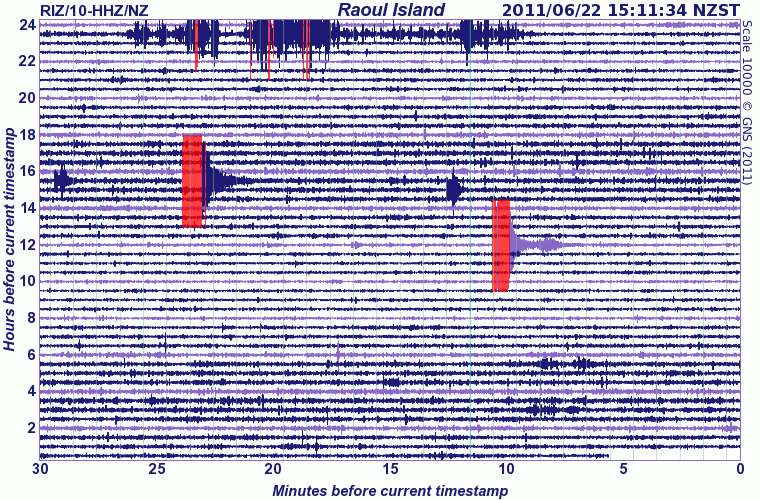 4. seismic activity charts geonet.org.nz here showing ghost echo from 1.18am Kermadec 5.0 that otherwise isn't noted, with e.g. Urewera local record: 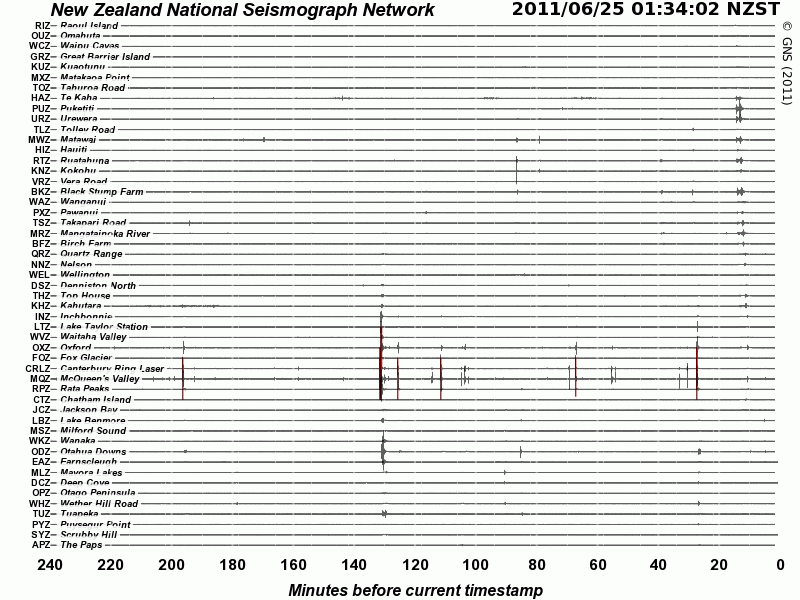 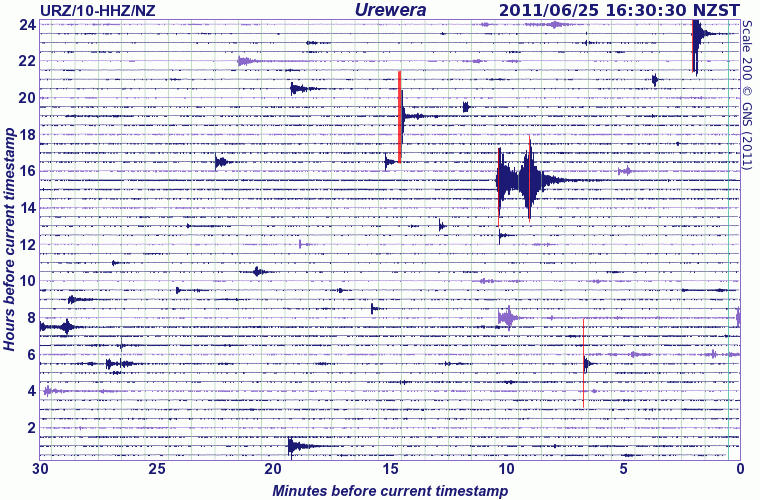 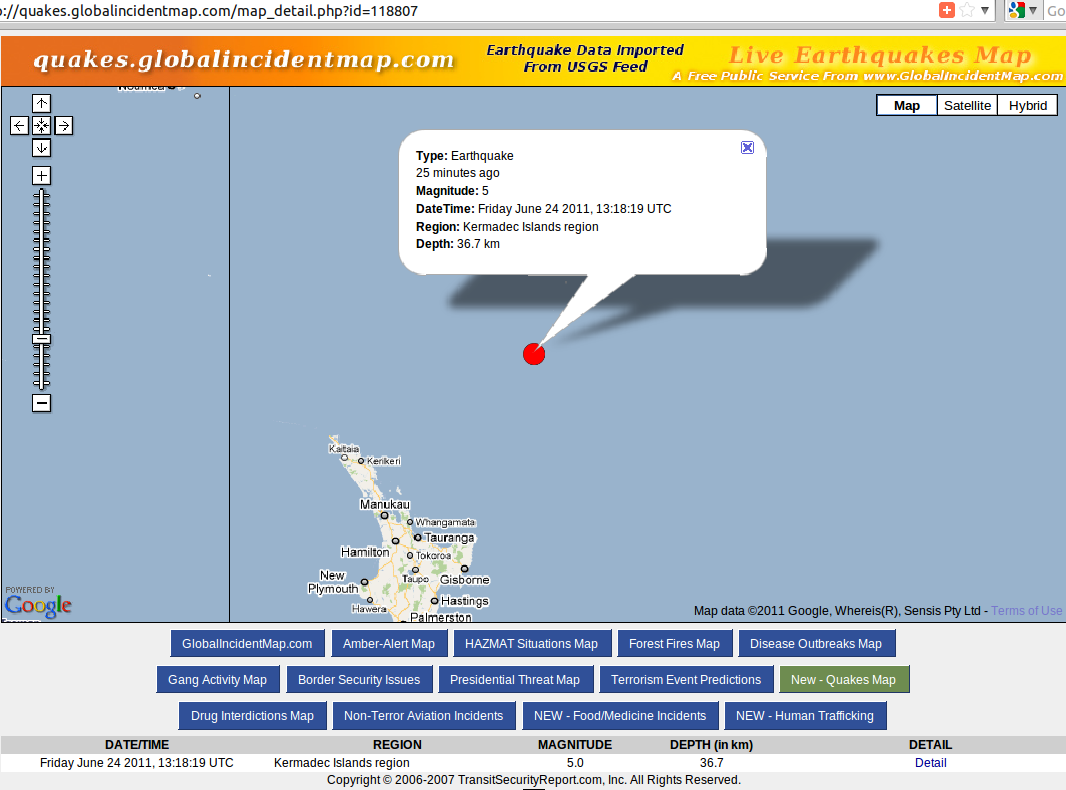 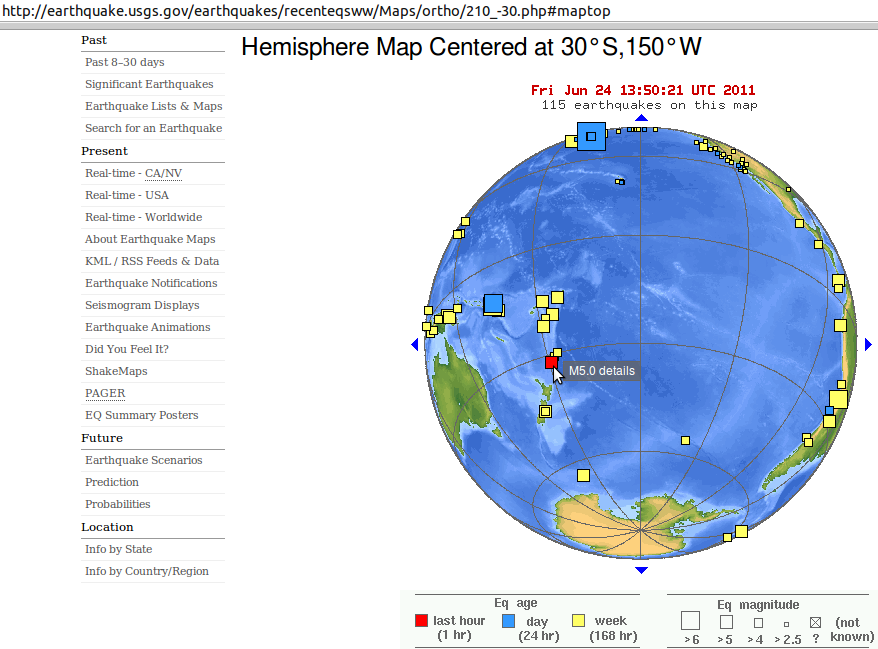 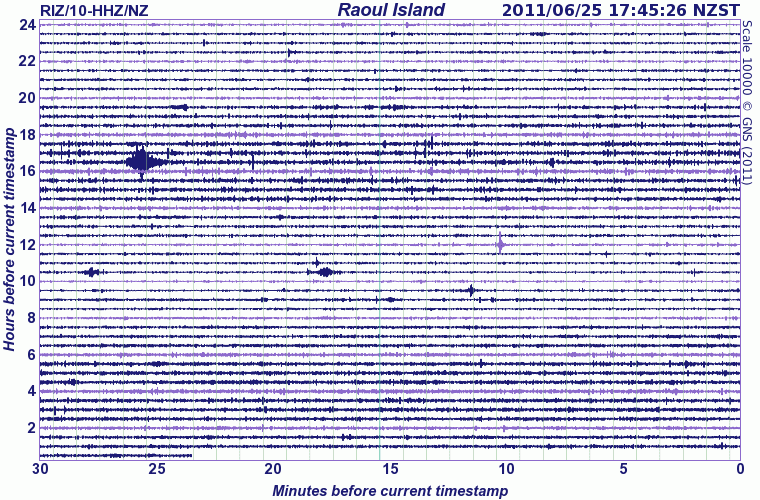 Compare this last screenshot frame with '3' above to see how small/remote the 250611 magnitude 5.0 shows up when the location is further from Raoul Island - L'Esperance Rock. We are dependent on US/Australian seismology to get proper information about events affecting New Zealand that occur on the Kermadec Trench; so maintaining active watch and scientific links are probably very important. Y O U ~ H A V E ~ B E E N ~ W A R N E D ! The above quake hunt sequence ended 1.20am 270611 NZST with a mag' 4.4 local quake following 5.7 south-west Tonga Trench ridge quake shakes NZ - continued notes there - and timed an hour after a Papua 6.4 and 5.4 etc new shock sequence. Conclusion: there is no immediate discernible effect from distant Pacific Rim quakes upon local/Canterbury quake events. Moderate fault-stress transfer through Tonga/Kermadec trenhces, to the north of New Zealand, can be observed, however. [N.B. delay period from Alaska to NZ has proven to be ~11 days: event 4a below] [1] 04 July 2011, large new aftershock imminent: 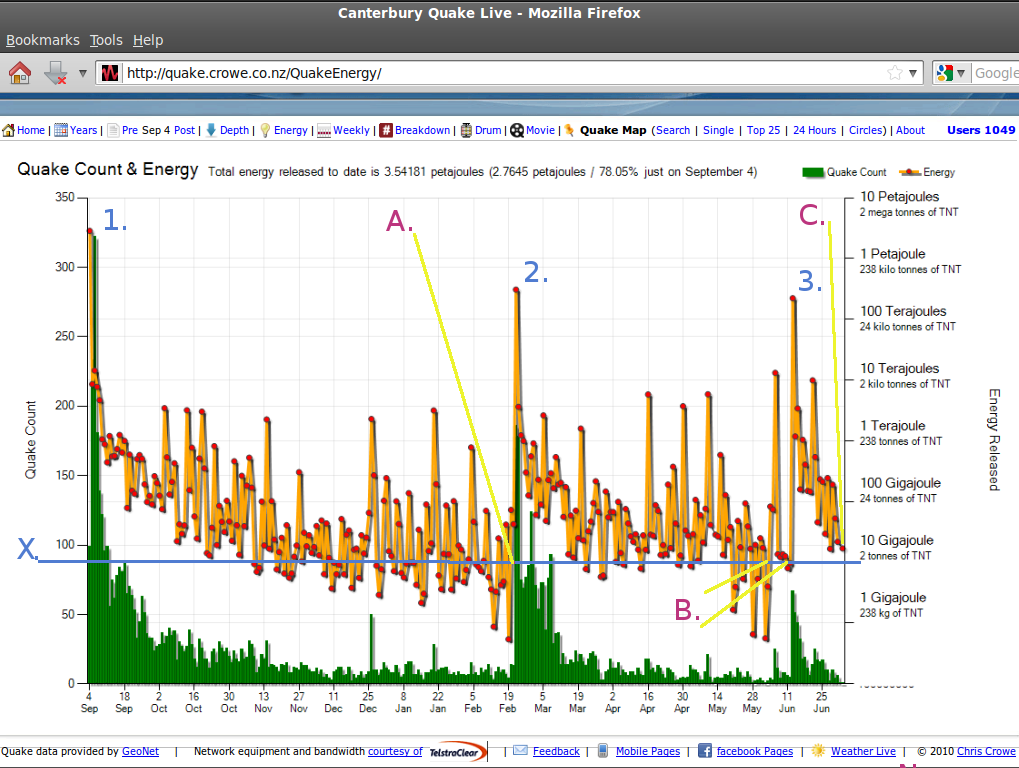 The graph quake.crowe.co.nz/QuakeEnergy can show us how soon to expect the next Christchurch 6+ earthquake, by observing energy conditions between the previous three, viz: Local earthquakes: 1. 4 September 2010 magnitude 7.1 ; 2. 22 February 2011 6.3 ; 3. 13 June 2011 6.3. Line X. is the 10-Gigajoule average daily energy-release line: once daily aftershocks have fallen into this zone then the driver for the next Christchurch 6+ earthquake is here. Historic points A. and B. on line X. indicate where point C. is heading to in the near future - averaging ten Gigajoules of aftershock daily energy-release - which will shortly precede the next Christchurch 6+ earthquake, most likely. N.B. Proven Correct yet again, insofar as timing and energy release, though not yet Canterbury location (pending): 4. - initial prediction was made for July 2011, then.. 4a. 05 July 2011 magnitude 6.5 150km-deep under Lake Taupo Volcano 4b. 07 July 2011 magnitude 7.6 20km-deep within Kermadec Trench - 7.6 Tsunami Alert 'SAFE ~ tidal marine threat only' 4c. 23 December 2011 magnitude 6.0 Pegasus Bay ... Explaining the science behind quakes "it would not be surprising if the region experienced another strong earthquake, similar in magnitude to the Darfield quake, in the next decade" The Press 28/07/2011 Early Earthquake Warning System in iOS 5 for Japanese Users macrumors.com/2011/08/21/ Fault research funding bid failed "GNS Science unsuccessfully pushed for more government funding to investigate faults under Christchurch after the September earthquake last year" The Press 20/10/2011 Floating design allows building on faultlines "There is nothing that says you can't.. The Alpine Fault is 600km long and runs along the western edge of the Southern Alps, marking the boundary between the Pacific and Australian tectonic plates. It is one of the world's major geological features and scientists believe it has a high probability of rupturing in the next 40 years, potentially generating a magnitude 8 quake" The Press 22/10/2011 Kiwi in line for big payout on quake-damaged office tower "Christchurch's tallest office tower - the PricewaterhouseCoopers building - will be demolished and its landlord Kiwi Income Property Trust will get a big insurance payout to compensate it, pleasing analysts who follow the stock" NZ Herald 26 Oct 2011 Fracking May Have Caused 50 Earthquakes in Oklahoma treehugger.com blog 3 Nov 2011 + U.S. Government Confirms Link Between Earthquakes and Hydraulic Fracturing "On 5 November an earthquake measuring 5.6 rattled Oklahoma and was felt as far away as Illinois. Until two years ago Oklahoma typically had about 50 earthquakes a year, but in 2010, 1,047 quakes shook the state. Why? In Lincoln County, where most of this past weekend's seismic incidents were centered, there are 181 injection wells, according to Matt Skinner, an official from the Oklahoma Corporation Commission, the agency which oversees oil and gas production in the state. Cause and effect? The practice of injecting water into deep rock formations causes earthquakes, both the U.S. Army and the U.S. Geological Survey have concluded.." oilprice.com 8 Nov 2011 Roger Sutton receiving mixed review "people in broken homes struggling to find answers often targeting him personally" The Press 19 Dec 2011 Christchurch authorities kick in quake response "Earthquake Recovery Minister Gerry Brownlee.. said that before today's aftershocks, he had started to relax and so the series of terrifying earthquakes took him by surprise.. less damage than that created on June 13.. 'We're still within the decay curve, that we've published and republished a number of times over the last few months, and so there was a probability that we could have one of these - it was a low probability.' The Minister said geotechnical officials reckon the damage today is 30% or 40% of what was caused by June's major aftershock. 'The fact that we've had it gets it out of the way so let's look at the bright side - the damage hasn't been as extensive as some of the other events,' he said." tvnz.co.nz/national-news 23 Dec 2011 |
| Page Sponsor detail completed here | |
Back to Sept 4 quake | government | InfoHelp home
|
Free |
Copyright © Canterbury Technology Ltd Edit version 12:30PM GMT+12 20/11/12 |